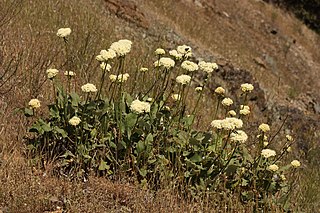
Eriogonum is a genus of flowering plants in the family Polygonaceae. The genus is found in North America and is known as wild buckwheat. This is a highly species-rich genus, and indications are that active speciation is continuing. It includes some common wildflowers such as the California buckwheat.

Eriogonum fasciculatum is a species of wild buckwheat known by the common names California buckwheat and flat-topped buckwheat. Characterized by small, white and pink flower clusters that give off a cottony effect, this species grows variably from a patchy mat to a wide shrub, with the flowers turning a rusty color after blooming. This plant is of great benefit across its various habitats, providing an important food resource for a diversity of insect and mammal species. It also provides numerous ecosystem services for humans, including erosion control, post-fire mitigation, increases in crop yields when planted in hedgerows, and high habitat restoration value.
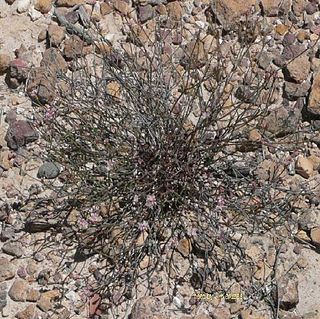
Eriogonum apricum is a rare species of wild buckwheat known by the common name Ione buckwheat. It is endemic to Amador County, California, in the United States.

Eriogonum arborescens is a species of wild buckwheat known by the common name Santa Cruz Island buckwheat.

Eriogonum davidsonii is a species of wild buckwheat known by the common name Davidson's buckwheat. This plant is native to the southwestern United States and northern Baja California. It grows in sandy or gravelly soils, mixed grassland, saltbush, chaparral, sagebrush communities as well as oak and montane conifer woodland. It is a spindly annual herb growing up to 40 centimeters in height. Leaves are fuzzy, basal, and round with wavy or wrinkly margins fuzzy. They are two centimeters wide. The plant is variable in appearance, but is usually erect with thin, naked, neatly branching stems bearing clusters of tiny flowers at widely spaced nodes. Each flower is about 2 millimeters wide, bell-shaped, and can be white, pink or red. Flowering occurs May to September.
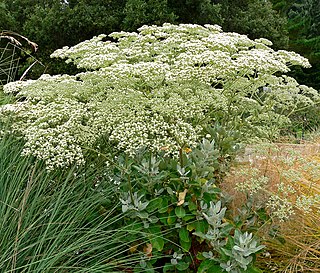
Eriogonum giganteum, with the common name St. Catherine's lace, is a species of wild buckwheat in Southern California.
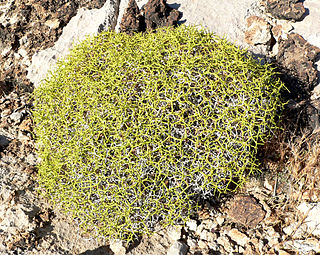
Eriogonum heermannii is a species of wild buckwheat known by the common name Heermann's buckwheat. It is native to the southwestern United States from California to Utah where it grows on rocky slopes, desert flats, and dry washes.

Eriogonum microthecum is a species of wild buckwheat known by the common name slender buckwheat. It is native to the western United States where it is found in a variety of habitats, particularly in dry areas such as deserts.

Eriogonum nidularium is a species of wild buckwheat known by the common name birdnest buckwheat. It is native to the sandy flats and desert dry washes of the Mojave Desert and Great Basin in the western United States, where it is common and abundant. This is a distinctive annual herb producing a thin, multibranched stem which curves in on itself to form a rounded, tangled mass.
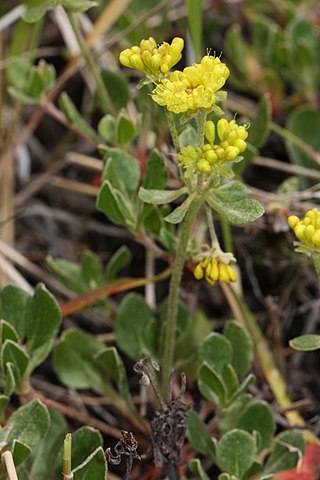
Eriogonum umbellatum is a species of wild buckwheat known by the common name sulphurflower buckwheat, or simply sulphur flower. It is native to western North America from California to Colorado to central Canada, where it is abundant and found in many habitats, including the sagebrush steppe and alpine areas. It is an extremely variable plant and hard to identify because individuals can look very different from one another. Also, there are many varieties. It may be a perennial herb blooming by summer with stems 10 centimeters tall and two to six clusters of flowers, with a whorl of leaves below the stems, or a sprawling shrub approaching two meters high and wide. The leaves are usually woolly and low on the plant, and the flowers come in many colors from white to bright yellow to purple.

Eriogonum wrightii is a species of wild buckwheat known by the common names bastardsage and Wright's buckwheat. It is native to the Southwestern United States, California, and northwest Mexico, where it grows in many plant communities, such as chaparral, in rocky habitats from mountains to deserts.

Eriogonum flavum is a species of wild buckwheat.
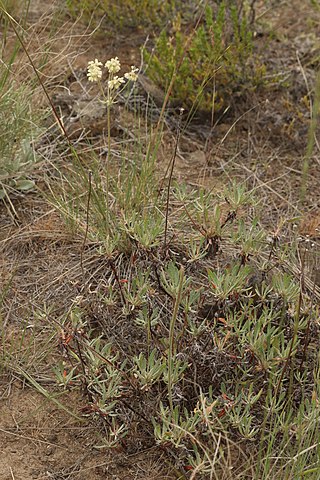
Eriogonum heracleoides is a plant of western North America that has many flowering clusters which are usually cream colored, or off-white. It can usually be found in rocky areas, such as sagebrush deserts and Ponderosa pine forests. Parsnipflower buckwheat is in the genus Eriogonum and the family Polygonaceae, which is a family of plants known as the "knotweed family". It inhabits much of the western part of the United States and southern British Columbia.
Eriogonum breedlovei is a rare species of wild buckwheat known by the common name Paiute buckwheat. It is endemic to the High Sierra Nevada of California, where its two varieties are uncommon members of the flora in granite and limestone rocky high mountain habitat.
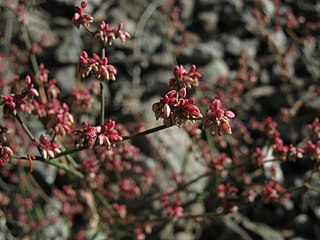
Eriogonum hoffmannii is a species of wild buckwheat known by the common name Hoffmann's buckwheat. It is endemic to Inyo County, California, where it is found only in the mountains around Death Valley; most of the known populations of the plant are located in Death Valley National Park. The plant grows in the desert scrub on the slopes of the Panamint, Black, and Funeral Mountains.

Eriogonum kennedyi is a species of wild buckwheat known by the common name Kennedy's buckwheat.

Eriogonum spergulinum is a species of wild buckwheat known by the common name spurry buckwheat.

Eriogonum sphaerocephalum is a species of wild buckwheat known by the common names rock buckwheat and round-headed desert buckwheat. It is native to the western United States.
The Bonny Doon Ecological Reserve is a nature preserve of 552 acres (2.23 km2) in the Santa Cruz Mountains of California, United States. The reserve protects several rare and endangered plant and animal species within an area known as the Santa Cruz Sandhills, an ancient seabed containing fossilized marine animals.
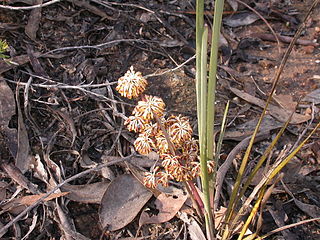
Lomandra multiflora, also commonly known as many-flowered mat rush, mat rush and many flowered mat-lily, is a perennial, rhizomatous herb found in Australia and Papua New Guinea. The mat rush is distributed widely in the region and common within its preferred growing conditions. Its conservation status is considered not to be of concern and risk.





















